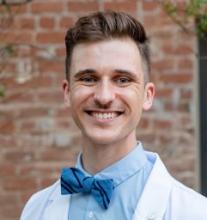
Faculty Mentor: Rita Sattler, Ph.D.
Research Interests: Neurodegeneration, iPSCs, RNA editing, glial cells, pediatric neurology, cerebral organoids
About Me:
Born and raised in Columbus, Ohio, I attended The Ohio State University for my bachelor's degree as a double major in Neuroscience and Psychology and received a Master's in Physiology from the University of Cincinnati College of Medicine. During this time, I conducted research on stress-induced changes to dopaminergic neural circuitry and the neuroimmune system during pregnancy. Following graduation, I worked in the lab of Jaime Imitola, MD (now Vice Chair of Neurology Research at UConn Health) where I found my passion in pursuing translational research as we worked together to study neuroimmune signaling in cerebral organoids and saw patients with multiple sclerosis and other neurodegenerative conditions in the clinic. I also spent time in clinical research at Nationwide Children's Hospital with the neuromuscular team, where I solidified my desire to pursue an MD/PhD after seeing the impact that physician-scientists were making with gene therapies for children born with deadly conditions like spinal muscular atrophy. Following this, I worked as a senior research associate and lab manager in the lab of Mark Hester, PhD, at the Institute for Genomic Medicine at Nationwide Children's Hospital where we used cerebral organoids to study neurodevelopmental conditions and neurodegenerative diseases like Alzheimer's.
Now as an MD/PhD student at the University of Arizona College of Medicine – Phoenix and as a PhD student in CTS, I am pursuing research at Barrow Neurological Institute to study the neuroimmunology and genetic alterations seen in ALS and related dementias using patient-derived iPSCs and cellular models. My goal is to eventually become a physician-scientist specializing in the research and care of patients with neurological conditions.
When I'm not studying or in the lab, I can be found trail running the mountain ranges of Phoenix, hiking and rock climbing in Sedona/Flagstaff, cycling, training for triathlons, cooking vegan food, and spending time with my partner and our German Shepherd.
Honors & Awards:
American Academy of Neurology Futures in Neurological Research (FiNR) Scholarship 2023
Child Neurology Foundation Neurodevelopmental Disabilities (NDD) Summer Research Scholarship 2022
Graduation with Honors in the Arts & Sciences 2016
Graduation with Honors Research Distinction in Neuroscience 2016
Resident Advisor of the Month, NRHH at OSU 2016
1st Place, Denman Undergraduate Research Forum 2016
2nd Place, Invited Oral Symposium, mGluRs Conference 2015
Arts and Sciences Undergraduate Summer Research Fellowship 2015
Arts and Sciences Undergraduate Research Scholarship 2015
Social and Behavioral Sciences Research Grant 2015
Dean’s List 2014-2016
Selected Publications:
1. Fair SR, Schwind W, Julian DL, Biel A, Ramadesikan S, Westfall J, Miller KE, Kararoudi MN, Hickey SE, Mosher TM, McBride KL, Neinast R, Fitch J, Lee D, White P, Wilson RK, Bedrosian TA, Koboldt DC, Hester ME. (2023). Cerebral organoids containing an AUTS2 missense variant model microcephaly. Brain. 2023, 146(1), p. 387-404 https://doi.org/10.1093/brain/awac244
2. Chen S, Chang Y, Li L, Acosta D, Li Y, Guo Q, Wang C, Turkes E, Morrison C, Julian D, Hester ME, Scharre DW, Santiskulvong C, Song SX, Plummer JT, Serrano GE, Beach TG, Duff KE, Ma Q, Fu H. Spatially resolved transcriptomics reveals genes associated with the vulnerability of middle temporal gyrus in Alzheimer’s disease. Acta Neuropathologica Communications. 2022 Dec;10(1):1-24. https://doi.org/10.1186/s40478-022-01494-6
Fair SR*, Julian D*, Hartlaub AM, Pusuluri ST, Malik G, Summerfield TL, Zhao G, Hester AB, Ackerman IV WE, Hollingsworth EW, Ali M, McElroy CA, Buhimschi IA, Imitola J, Maitre NL, Bedrosian TA, Hester ME. (2020) Electrophysiological maturation of cerebral organoids correlates with dynamic morphological and cellular development. Stem Cell Rep. 15 (4), 855-868.
*indicates co-first authorship

